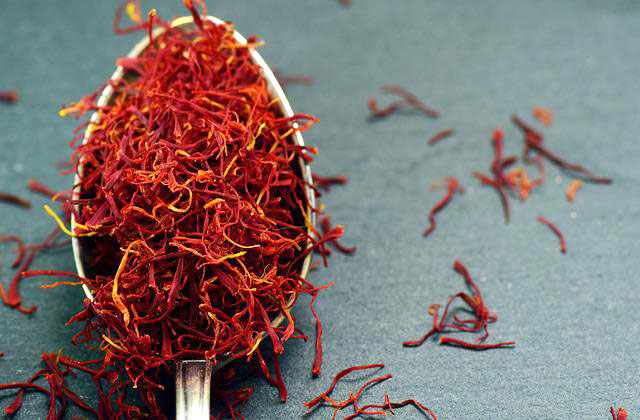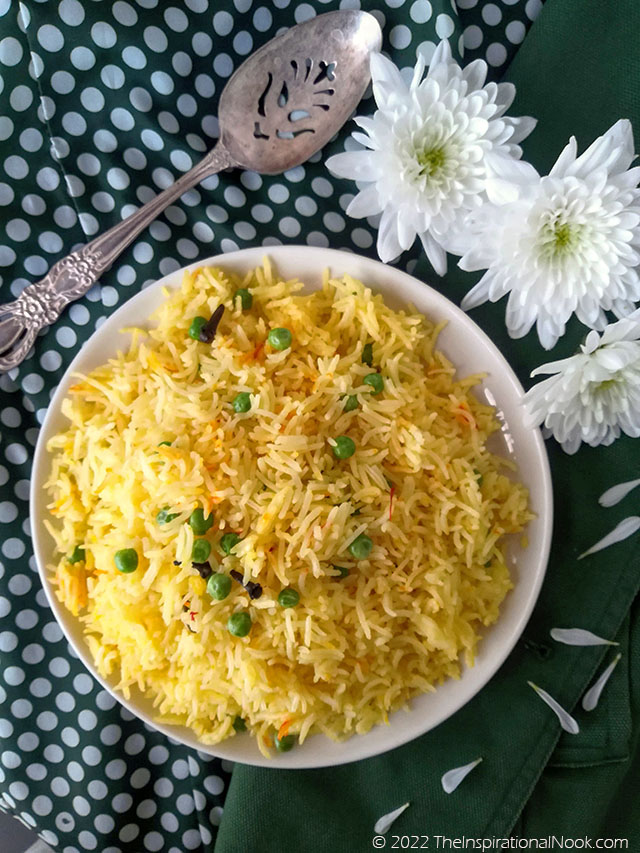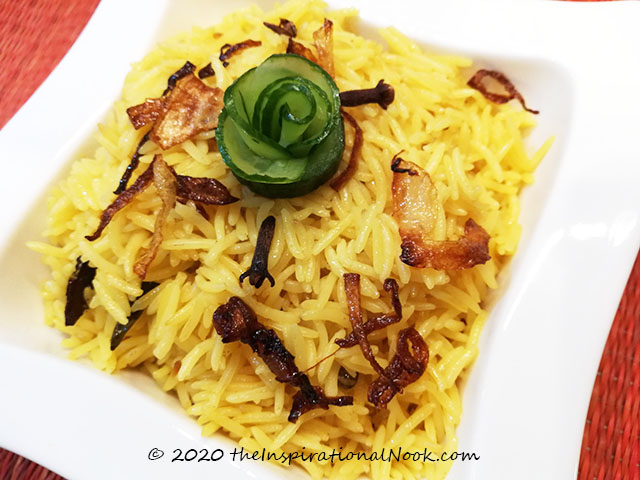Cooking with Saffron | Saffron Yellow Rice with Peas
Today I'm cooking with saffron. Also known as 'red gold', saffron is the most expensive spice in the world! Thankfully I only require a small pinch of saffron to make this fluffy and fragrant Saffron Yellow Rice with Peas using long grain basmati rice.
Just a tiny pinch of saffron goes a long way in not just coloring the rice a warm, golden shade of yellow but more importantly, dispensing that unique, delicate saffrony fragrance that wafts off the hot yellow rice and perfumes the air.
Fun Facts about Saffron
- Did you know that saffron strands are harvested from the flowers of the Crocus flower (Crocus sativus)? The saffron strands come from the 3 crimson colored, thread-like strands of stigmas from each flower.
 |
| Crocus sativus flowers with their red stigmas (saffron strands) |
- The finest quality saffron and world's most expensive saffron only uses the tips of the dried stigmas. The remaining parts of the stigmas are used to make lower grade saffron.
- Saffron is the most expensive spice in the world because of the time it takes to hand harvest it and the miniscule quantity a harvest produces.
- It takes about 750,000 crocus flowers to make 1 pound of saffron strands.
- Kashmir produces some of the highest quality saffron in the world and Iran produces 90% of saffron.
- Real saffron can cost up to $5,000 per pound.
Watch the video below to see the farmers in Kashmir harvest saffron flowers from their saffron farms. It's no wonder real saffron is so expensive.
How to Tell if Saffron is Real
With something this valuable, it's but natural to have fakes floating around in the market. So how to tell the difference between real saffron and fake? Smell, appearance, taste and time for color release in water are the main ways to tell the difference between real vs. fake saffron.
 |
| Real saffron threads |
- Smell: Real saffron has a distinct, sweet smell. Think of a dish made with saffron, like paella. That's the unforgettable aroma that you should recognize immediately when you smell saffron threads.
- Appearance: Look carefully at the picture above. Saffron threads are trumpet shaped, bulging at one end and tapered at the other. False saffron (picture below) looks feathery and comes from the Safflower (Carthamus tinctorius) flower.

False Saffron
Saffron Images by Ulrike Leone from Pixabay - Taste: Real saffron tastes bitter.
- Time for color release in water: Real saffron placed in water takes time to release its yellow color from 15 minutes to up to an hour. The saffron strands remain red after color release and remain intact if rubbed between your fingers. Fakes, on the other hand, release color quickly or not at all and the threads may lose their color.
Cooking with Saffron
So now that we know how to identify real saffron, let's get cooking!
I've made an Indian Saffron Rice using long grain basmati rice. The yellow rice recipe using saffron is at the bottom of this post, but first, I share my tips on how to make my saffron pulao fluffy and light.
This saffron rice is cooked in one pot on the stove without using a rice cooker.
Tips and Tricks to Make the Fluffiest Saffron Pea Rice
When it comes to making the perfect saffron rice it all boils down to proportions and timing. Here are the key things to keep in mind:
1. Choose the right rice
2. Choose the right vessel to cook the rice in
3. Measure rice: water ratio correctly
4. Pre-wash the basmati rice
5. Soak basmati rice for 30 minutes
6. Fry drained rice carefully
7. Have pre-Measured water (with saffron) just under boiling point ready to add to fried rice
8. Boil rice uncovered on high until 'holes' appear in rice.
9. Cover rice and cook on low for 15 minutes.
10. Add frozen peas and fluff lightly with a fork.
11. Turn off the stove and keep covered for 5 minutes.
12. Partially uncover vessel and leave undisturbed for 15- 20 minutes.
13. Plate rice using a large spoon
What is the Trick to Making Fluffy Rice?
1. Choose the right rice
The best rice for fluffy saffron rice is white basmati rice. If cooked correctly, white, long-grained basmati rice cooks into a beautiful, fragrant, light and fluffy rice that is not mushy or sticky.
I use "Daawat Traditional Basmati Rice" or "India Gate Basmati Rice"
2. Choose the right vessel to cook the rice in
Choosing the right vessel is very important. To make 2 cups (uncooked) basmati rice, I use a non-stick, 12 inch vessel with a tight fitting lid. The timing for this recipe is based on cooking in a non-stick vessel.
If you use a heavy dutch oven or cast iron pot, the steaming time for cooking the rice will be different because of the rate at which these thick and heavy vessels get hot and retain heat.
3. Measure the rice: water ratio correctly
It is important to measure the basmati rice precisely, since the quantity of water used is exactly double the quantity of rice.
So for 2 cups of rice, 4 cups of boiling water will be used.
When measuring the rice, each measuring cup of rice should contain a flat, leveled measure of rice. Use the same measuring cup to measure double the quantity of water.
4. Pre-wash the basmati rice
Rinse the basmati rice two to three times in water to remove excess starch from the grains. Excess starch makes the rice sticky, so removing some of the starch prior to cooking will make for a fluffier rice. With each wash the water will run a little clearer.
After rinsing, do not squeeze the rice or the grains will break.
5. Soak the basmati rice for 30 minutes before cooking
After rinsing the basmati rice, cover the basmati rice in room temperature water and leave it to soak for 30 minutes. The rice will start to absorb the water which means the rice will require less cooking time.
6. Fry the drained rice gently
Frying the rice gently ensures that each grain is coated with a light coating of oil, which help keeps the grain whole and prevents it from breaking down and becoming mushy when cooked.
To fry the rice, add the drained rice a handful at a time to the hot oil. When draining the rice, handle the soaked rice gently. The soaked rice is very fragile and the grains will break easily. Do not squeeze the rice, but just take the rice in loose handfuls and add it to the hot oil. Move the rice in the hot oil very minimally and gently.
7. Keep the pre-measured water (with saffron) simmering on the stove
This is important. When it's time to add the water to the rice, the water must be at or just below boiling point. Salt the water generously so that it tastes salty.
8. Boil rice uncovered on high until 'holes' appear in rice
On high flame, boil the rice uncovered. Watch carefully for little holes to appear in the rice as the liquid content reduces.
9. Cover rice and cook on low for 15 minutes
Once the holes appear in the rice, cover the vessel with a tight fitting lid and reduce the heat to very low. Allow the rice to steam undisturbed for 15 minutes.
 |
| Boil rice with water until rice forms holes |
10. Add frozen peas and fluff lightly with a fork
Add the frozen peas and fluff the rice very gently (3 or 4 fluffs) with a fork to incorporate the peas in the rice. Recover the rice.
The frozen peas will bring the rice temperature down, so follow step 11. to defrost the peas.
(If not using frozen peas, skip 10 and 11. Test rice to make sure it is cooked and go straight to step 12)
 |
| Fluff rice and peas lightly with a fork |
11. Turn off the stove and keep covered for 5 minutes.
This step helps to defrost the frozen peas.
12. Partially uncover vessel and leave undisturbed for 15- 20 minutes.
This step is important. The steamy hot rice needs to cool a bit before handling. After 15-20 minutes of resting undisturbed and partially uncovered, the steamed saffron rice has firmed up enough to hold its shape when handling. Each grain of rice has been coated with a layer of oil which keeps the grains separate, firm and fluffy.
 |
| Leave cooked rice partially uncovered to rest and cool undisturbed for 15 minutes |
13. Plate rice using a large spoon
To plate rice in a serving dish, use a large spoon. Loosen rice in layers from the top of the vessel and spoon airily into a serving dish.
FAQs
Is there a cheaper substitute for saffron?
Unfortunately, there is no close substitute for saffron fragrance. However, for the yellow color, ground turmeric powder is a good substitute. Here's my recipe for Anglo Indian Yellow Coconut Rice using turmeric.
Annatto seeds are also a good substitute to color the rice yellow. Both turmeric and annatto are cheap substitutes for saffron, though more for the coloring rather than flavoring.
How to Reheat Saffron Rice in Microwave
This rice reheats really well in the microwave. Sprinkle the rice with water, cover and microwave until heated.
Saffron Yellow Rice and Peas Recipe
Ingredients:
☐ 1/2 teaspoon saffron strands
☐ 4 cups boiling water
☐3 whole cardamoms
☐ Cinnamon stick, 2 inch stick broken into 2-3 pieces
☐ 8 whole cloves
☐ 1 cup frozen peas
☐ Salt
☐ Vegetable oil- 3 tablespoons
Step-by-Step Instructions:
Step 1: Prep Rice
- Measure 2 cups of rice exactly i.e. each measuring cup of rice should contain a flat, leveled measure of rice. This is important because the measurement for the water is based off the rice measure. The quantity of water is exactly double that of the rice.
- Rinse the basmati rice two to three times in water to remove excess starch from the grains.
- After rinsing the basmati rice, cover the basmati rice in room temperature water and leave it to soak for 30 minutes.
- While the rice is soaking, soak a pinch of saffron in a little warm water and allow it to steep for the color to develop.
- While the rice is soaking, heat the pre-measured water and keep it simmering gently.
- Salt the water generously. To ensure that the rice is salted adequately, the water should taste salty.
Step 4: Fry Spices and Rice
- Heat vegetable oil in a large, non-stick vessel.
- When the oil is hot, add the cinnamon, cloves and cardamom. Fry lightly
- Carefully drain the soaked rice. Add the drained rice, a handful at a time to the hot oil. When draining the rice, handle the soaked rice gently. The soaked rice is very fragile and the grains will break easily. Do not squeeze the rice, but just take the rice in loose handfuls and add it to the hot oil. Move the rice in the hot oil very minimally and gently.
Step 5: Add Pre-Measured Boiling Water
- Add the boiling water and saffron to the rice.
- Note: When it's time to add the water to the rice, the water must be at or just below boiling point.
- On high flame, boil the rice uncovered. Watch carefully for little holes to appear in the rice as the liquid content reduces.
Step 7: Cover Rice and cook on low for 15 minutes
- Once the holes appear in the rice, cover the vessel with a tight fitting lid and reduce the heat to very low. Allow the rice to steam undisturbed for 15 minutes.
Step 8: Add Frozen Peas
- Add the frozen peas and fluff the rice very gently (3 or 4 fluffs) with a fork to incorporate the peas in the rice.
- Recover the rice. Then turn off the stove and keep covered for 5 minutes to allow peas to defrost.
Step 9: Leave Rice to Rest
Check for doneness. Then, partially uncover vessel and leave rice to rest undisturbed for 15- 20 minutes.
Step 10: Serve
- Use a large spoon to plate rice in a serving dish. Loosen rice in layers from the top of the vessel and spoon airily into a serving dish.



